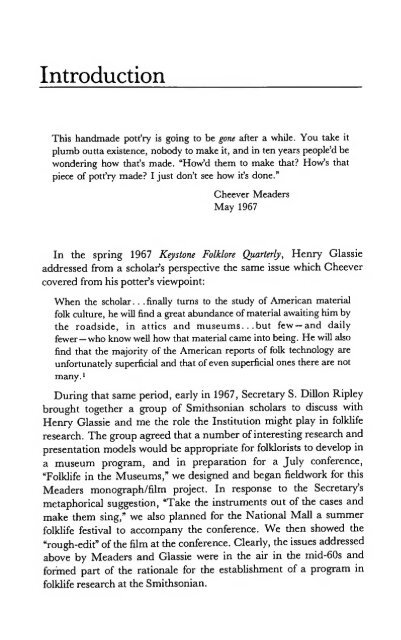Smithsonian Contributions - Smithsonian Institution Libraries
Smithsonian Contributions - Smithsonian Institution Libraries
Smithsonian Contributions - Smithsonian Institution Libraries
Create successful ePaper yourself
Turn your PDF publications into a flip-book with our unique Google optimized e-Paper software.
Introduction<br />
This handmade pott'ry is going to be gone after a while. You take it<br />
plumb outta existence, nobody to make it, and in ten years people'd be<br />
wondering how that's made. "How"d them to make that? How's that<br />
piece of pott'ry made? I just don't see how it's done."<br />
Cheever Meaders<br />
May 1967<br />
In the spring 1967 Keystone Folklore Quarterly, Henry Glassie<br />
addressed from a scholar's perspective the same issue which Cheever<br />
covered from his potter's viewpoint:<br />
When the scholar.. .finally turns to die study of American material<br />
folk culture, he will find a great abundance of material awaiting him by<br />
the roadside, in attics and museums. . .but few —and daily<br />
fewer—who know well how that material came into being. He will also<br />
find that the majority of the American reports of folk technology are<br />
unfortunately superficial and that of even superficial ones there are not<br />
many. 1<br />
During mat same period, early in 1967, Secretary S. Dillon Ripley<br />
brought together a group of <strong>Smithsonian</strong> scholars to discuss with<br />
Henry Glassie and me the role the <strong>Institution</strong> might play in folklife<br />
research. The group agreed that a number of interesting research and<br />
presentation models would be appropriate for folklorists to develop in<br />
a museum program, and in preparation for a July conference,<br />
"Folklife in the Museums," we designed and began fieldwork for this<br />
Meaders monograph/film project. In response to the Secretary's<br />
metaphorical suggestion, "Take the instruments out of the cases and<br />
make them sing," we also planned for the National Mall a summer<br />
folklife festival to accompany the conference. We then showed the<br />
"rough-edit" of the film at the conference. Clearly, the issues addressed<br />
above by Meaders and Glassie were in the air in the mid-60s and<br />
formed part of the rationale for the establishment of a program in<br />
folklife research at the <strong>Smithsonian</strong>.

















